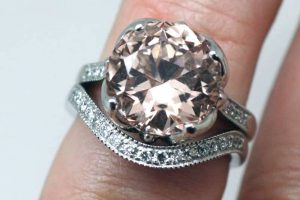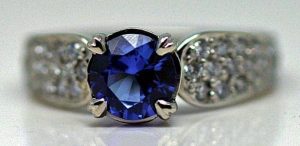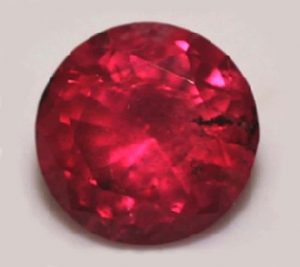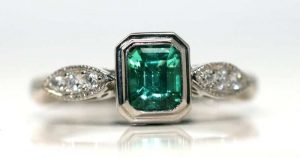All about coloured gemstones
What you need to know about gemstones used in fine jewellery
Gemstones are classified in the same four ways as diamonds, plus an extra one you need to be very aware of – hardness.
Why is gemstones hardness important?
Understanding gem cut, colour, clarity, carat (weight) and hardness
Gemstone basics: The four ‘C’s plus ‘H’
When choosing a gemstone, you need to assess cut, carats, clarity and colour. Just as it is with diamonds, the value of a gemstone depends on its rarity, size and quality.
Unlike diamonds though, you also need to consider hardness.
Choose a gemstone that’s ‘tough’ enough

Large morganite set in recycled platinum. Note the wide claws designed to protect the edges of the stone.
When choosing a gemstone for an engagement ring, it’s also important to consider ‘H’ — hardness. Many gemstones are ‘soft’ or fragile and can easily get damaged particularly when worn on the hands every day.
You’ll see when we talk about gemstones here, we usually only mention types that we consider suitable for setting in rings. (Where they’re more likely to be exposed to rough handling.)
That said, where there’s a will, there’s usually a way.
Design to limit the risk
Emerald is a classic example of a popular gemstone that’s relatively fragile. yet you see them everywhere.
Take a close look and you’ll see they’re most often held in a bezel or ‘roll-over’ setting to protect the edges and corners.
 Gemstone Cut
Gemstone Cut
As with diamonds, it’s the cut that reveals not just the value, but the true beauty of a gemstone.
Cut can bring a stone to life … or kill it
Cut quality affects the depth of colour and the liveliness of the gemstone.
Poor cutting can cause an otherwise beautiful gemstone to look drab and dull. On the flip side, good cutting can’t enhance a low-quality gemstone.
When the gemstone you’re looking at reads well but looks below par, examine the cut.
If the cut is good, you can assume the gemstone wasn’t good to start with.
If the cut is poor, you could (possibly) be looking at a good gemstone cut badly.
And now the good news
A good quality, but poorly cut gemstone can easily be recut, usually at relatively little expense.
However, do keep in mind that gem cutters are not magicians. They can only subtract, so the recut gemstone will be smaller than the original.
To see how a gemstone can be transformed, take a look at the evolution of this morganite ring.
 Gemstone Colour
Gemstone Colour
When it comes to colour, the ‘right’ colour is very much a matter of personal taste.
Generally, the more ‘close to the colour ideal’ for its type (or exceptionally vivid) and uniform the colour, the more valuable a stone will be.
How colour is described
In gemstones, colour comprises of:
- Hue — its pure spectral colour (from red to violet)
- Intensity — the brightness or dullness of the colour
- Tone — the amount of background white, black, grey or brown
- Distribution — the evenness (or unevenness) of colour
The colour of a gemstone is a combination of its pure spectral hue and background tint.
The pure spectral and background colours go together to create the tone.
For example, if white is present with red, the gemstone will appear lighter in colour. If black is present, the gemstone will appear darker.
Often, the closer a gemstone is to the pure hue, the more valuable it is.
Light source is important
By the way, the light source you use is very important when evaluating a gemstone since different types of artificial lights emit different spectra.
This can have a significant impact on the appearance of a gemstone’s colour.
Fluorescent lights are weak in red rays (they’re ‘cool’) — this can darken red gemstones and give them a purple tone.
Blue gemstones (like sapphires), are best viewed under fluorescent light or in daylight. Under incandescent light they appear much darker — almost black.
Be aware too that background colour impacts on how a gemstone appears.
Red gemstones appear even redder when viewed on an orange or yellow background.
White diamonds are often displayed on a blue background to reduce any yellow tones.
What you see may not be what you get
Perhaps one of the most common ways gemstone buyers are deceived is through the alteration of the colour of a gemstone. This can be achieved by chemical or radiation treatment.
Likewise colour can be altered by adding a coating or soaking the stone in coloured oil. It’s even possible to pass one gem variety off as a completely different gemstone altogether.
Be wary! Again, make sure you’re dealing with a reputable trader.

The gorgeous vivid blue of Tanzanite can only be revealed as a result of heat treatment
Heat treatment is usually okay – when disclosed
By the way, heat is another way of improving colour. When properly disclosed however, it’s not generally frowned upon within the industry.
Tanzanite is a great example of a gemstone that would look very ordinary were it not heat-treated as a standard practice.
 Gemstone Clarity
Gemstone Clarity
Like diamonds, the clarity of a gemstone is affected by flaws and inclusions.
But, unlike diamonds, in some gemstones certain types of inclusions can actually be very desirable.
Expect to see flaws and inclusions

Fair Trade Tanzanian ruby showing an eye-visible inclusion at about 3 o’clock
Flaws (or ‘feathers’) are generally more common in coloured gemstones than they are in diamonds.
As long as they aren’t in a vulnerable spot that will weaken the stone then it isn’t something most people worry about.
As for inclusions, their aesthetic importance varies with the tone of the gemstone. The darker the gemstone, the less visible inclusions are.
Inclusions are more visible in light, almost transparent gemstones.
Beware ‘flawless’ gemstones
Be warned! Flawless gemstones are rare and expensive. So if you do encounter a ‘flawless’ gemstone, view it with suspicion. It could be an imitation or a synthetic.
The only way to be certain is to have it tested by a professional gemmologist.
Inclusions can be desirable
Finally, the presence of inclusions can, in some instances, be desirable.
Gemmologists often use the type of inclusion to accurately identify a gemstone.
Certain inclusions will confirm a gemstone’s rarity (or not).
Two gemstones may look the same to the untrained eye, but one could be much more valuable than the other because of its origin.
 Gemstone Weight (Carats)
Gemstone Weight (Carats)
Between different types of gemstones, carat weight is not an indicator of relative size.
In other words, carat weight is only useful as a size indicator when comparing the same type of gem.
Specific gravity varies by gem type
Different gem materials have different densities (specific gravity).
As a result, whilst you may have two gems of exactly the same physical dimensions but of different types – say, garnet and sapphire – they will have different carat weights.
This is why gemstones are most often described by their physical dimensions rather than by their weight.
Bigger does not always mean more valuable
Sure, when it comes to gems like emeralds, rubies, sapphires, alexandrite and the like, larger stones attract higher prices by weight.
But other gemstones – particularly those from the quartz family – are readily available in sizes over 10 carats and do not attract a premium just because they’re big.
 Gemstone Hardness
Gemstone Hardness
When talking about hardness in relation to gems, we’re referring to ‘scratch’ hardness. That is, how likely the gemstone is to get scratched or chipped during day-to-day wear.
The harder a stone is, the safer it is from this kind of damage.
Take appropriate precautions in your design

Emeralds are a relatively fragile gemstone and are usually bezel-set to protect the edges and corners of this type of gem
It’s perfectly okay to use softer gemstones if you take appropriate precautions in the ring design. For example, using a bezel setting rather than a claw setting—like on the emerald ring shown here.
It all comes down to personal preference and the risk you’re prepared to take.
Mohs’ scale of hardness
Hardness in gemstones is measured on Mohs’ scale, which rates gemstones from 1 to 10.
Talc is softest. Diamond is hardest.
By the way, it’s important to know that the Mohs’ scale isn’t linear. The ‘gaps’ get bigger as the hardness increases, particularly between 9 and 10.
Diamond is exponentially harder than the next hardest (corundum, sapphire and ruby).
If you want to claw-set a gemstone for everyday use, we recommend that you do not choose a gemstone with a hardness of less than 8.0 on Mohs’ scale.
If you choose a bezel or channel setting, you can usually go down to 7.0 providing the gemstone is otherwise quite robust.
A quick note about Lab-created gemstones
Lab-created gemstones are not “imitations”
Contrary to what you might’ve been led to believe, lab-created (or synthetic) gem material is not an imitation. They’re the real deal, just not created in the same place as their natural counterparts.
Imitations are things made to look like a real gemstone but are completely different in their chemical make-up. Think fake leather and fake fur. They look real, but they’re completely different.
Lab-created gemstones, on the other hand, are industrially grown gems that have the same physical, optical and chemical properties as their natural counterparts.
So long as you’re made aware of what you’re buying, there’s nothing wrong with purchasing lab-created gemstones.
To learn more about synthetic gems, visit our section on lab-created gemstones.
Ready to start designing the perfect ring or other jewellery piece?
If you’re ready to get started, give us a call or drop us a line. We’d love to help you turn your ideas into reality.
Our Privacy Policy | Terms & Conditions
© 2018 Ethical Jewellery Australia.
All Rights Reserved.
ABN: 3810 6233 196

